The Numerical Simulation of a Submarine Based on a Dynamic Mesh Method
Abstract
:1. Introduction
2. Numerical Model
2.1. Governing Equations
2.2. Turbulence Model
3. Model Verification
3.1. Computational Domain and Grids
3.2. Dynamic Mesh Method and Boundary Conditions
3.3. Convergence Study
3.4. Validation of the Numerical Results
4. Results and Discussion
4.1. Analysis of the Wake Waves
4.1.1. Comparison between the Inflow Method and Dynamic Mesh Method
4.1.2. Wake Waves of the Steady Turning Motion
4.2. Influence of the Velocity
4.2.1. Pressure Coefficient Acting on the Submarine
4.2.2. Influence of the Velocity on the Pressure Coefficient
4.2.3. Influence of the Velocity on the Force
4.3. Influence of the Rotation Rate
5. Conclusions
- (1)
- The steady turning motion of the submarine causes the pressure difference between the port side and starboard side, which results from the difference in the velocity field distribution and the flow separation on both sides of the submarine. The velocity vector field on the plane of z = 0 reflects the characteristics of the flow field around the submarine during its turning motion. It can explain the surface pressure variation precisely through the analysis of the velocity vector field based on Bernoulli’s equation.
- (2)
- In the steady turning period, under the condition of the same rotation rate, the influences of the velocity on the wake waves, pressure coefficient and force are significant. The force components in both the tangential direction and normal direction increase as the velocity increases. This indicates that the forward velocity affects the flow field in terms of the pressure gradient, viscous shear stress gradient and wave-making intensity.
- (3)
- When the submarine retains the same velocity but changes in the rotation rate, the force component in the normal direction changes significantly. Decreasing the rotation rate will decrease the normal force. Thus, the normal force is strongly affected by the rotation rate. The tangential force tends to remain constant at the same time, indicating that it is independent of the rotation rate.
Author Contributions
Funding
Institutional Review Board Statement
Informed Consent Statement
Data Availability Statement
Conflicts of Interest
References
- Chen, Z.; Dai, Y.; Deng, F.; Ni, G. Mathematical model study and simulation analysis of submarine underwater rotary movement. Ship Sci. Technol. 2015, 37, 46–50. [Google Scholar]
- Zhang, L.; Deng, X.; Zhang, H. A review of dynamic mesh generation techniques and unsteady computing methods. Adv. Mech. 2010, 40, 424–447. [Google Scholar]
- Huang, C. Direct Simulation of Maneuver of the Underwater Vehicle Based on Overset Grid. Master’s Thesis, Wuhan University of Technology, Wuhan, China, 2018. [Google Scholar]
- Deng, F.; Dai, Y.; Chen, Z.; Zhang, B. Sliding mesh based on numerical simulation of rotating arms tests for submarines. Command. Control. Simul. 2016, 38, 122–126. [Google Scholar]
- Ma, Z.H.; Qian, L.; Martínez-Ferrer, P.J.; Causon, D.M.; Mingham, C.G.; Bai, W. An overset mesh based multiphase flow solver for water entry problems. Comput. Fluids 2018, 172, 689–705. [Google Scholar] [CrossRef] [Green Version]
- Sun, Z.; Liu, G.-J.; Zou, L.; Zheng, H.; Djidjeli, K. Investigation of Non-Linear Ship Hydroelasticity by CFD-FEM Coupling Method. J. Mar. Sci. Eng. 2021, 9, 511. [Google Scholar] [CrossRef]
- Windt, C.; Davidson, J.; Akram, B.; Ringwood, J.V. Performance Assessment of the Overset Grid Method for Numerical Wave Tank Experiments in the OpenFOAM Environment. In Proceedings of the ASME 2018 37th International Conference on Ocean, Offshore and Arctic Engineering, Madrid, Spain, 17–22 June 2018. [Google Scholar]
- Romano, A.; Lara, J.L.; Barajas, G.; Di Paolo, B.; Bellotti, G.; Di Risio, M.; Losada, I.J.; De Girolamo, P. Tsunamis Generated by Submerged Landslides: Numerical Analysis of the Near-Field Wave Characteristics. J. Geophys. Res. Ocean. 2020, 125, e2020JC016157. [Google Scholar] [CrossRef]
- Zaghi, S.; Mascio, A.D.; Broglia, R.; Muscari, R. Application of dynamic overlapping grids to the simulation of the flow around a fully-appended submarine. Math. Comput. Simul. 2015, 116, 75–88. [Google Scholar] [CrossRef]
- Cao, L.; Zhu, J.; Huang, K.; Ge, Y.; Wang, Z. Numerical simulation of a fully appended submarine model in steady turn. J. Nav. Univ. Eng. 2015, 27, 17–20. [Google Scholar]
- Zhang, D.; Yan, J.; Zhao, B.; Zhu, K. Numerical simulations of submarine rotating arms based on overset mesh. Sci. Technol. Eng. 2022, 22, 393–399. [Google Scholar]
- Mi, B.; Zhan, H.; Wang, B. Numerical simulation of dynamic derivatives based on rigid moving mesh technique. J. Aerosp. Power 2014, 29, 2659–2664. [Google Scholar] [CrossRef]
- Wu, J.; Zhang, E.; Zhong, L. Research on underwater vehicle’s thrust characteristics in the state of rotary motion. Ship Sci. Technol. 2018, 40, 1–7. [Google Scholar]
- Toxopeus, S.L.; Atsavapranee, P.; Wolf, E.; Daum, S.; Gerber, A.G. Collaborative CFD Exercise for a Submarine in a Steady Turn. In Proceedings of the International Conference on Ocean, Rio de Janeiro, Brazil, 1–6 July 2012. [Google Scholar]
- Lyu, X.; Tang, H.; Sun, J.; Wu, X.; Chen, X. Simulation of microbubble resistance reduction on a suboff model. Brodogr. Teor. I Praksa Brodogr. I Pomor. Teh. 2014, 65, 23–32. [Google Scholar]
- Cao, L.; Zhu, J.; Zeng, G. Viscous-Flow calculations of submarine maneuvering hydrodynamic coefficients and flow field based on same grid topology. J. Appl. Fluid Mech. 2016, 9, 817–826. [Google Scholar] [CrossRef]
- Pan, Y.; Zhou, Q.; Zhang, H. Numerical simulation of rotating arm test for prediction of submarine rotary derivatives. J. Hydrodyn. 2015, 27, 68–75. [Google Scholar] [CrossRef]
- Groves, N.C.; Huang, T.T.; Chang, M.S. Geometric Characteristics of DARPA (Defense Advanced Research Projects Agency) SUBOFF Models (DTRC Model Numbers 5470 and 5471); David Taylor Research Center Bethesda MD Ship Hydromechanics Department: Bethesda, MD, USA, 1989. [Google Scholar]
- Lin, J.; Ni, G.; Dai, Y.; Qu, D. Research on parameters’ change rule of submarine’s steady rotary movement. Ship Sci. Technol. 2014, 36, 31–33+37. [Google Scholar]
- Wang, X.; Lian, Z.; Xu, J.; Li, X. SUBOFF standard model underwater resistance test method. In Proceedings of the 14th National Congress on Hydrodynamics & the 28th National Conference on Hydrodynamics, Changchun, China, 8 August 2017; pp. 450–456. [Google Scholar]
- Liu, H.L.; Huang, T.T. Summary of DARPA Suboff Experimental Program Data; Defense Technical Information Center: Fort Belvoir, VA, USA, 1998. [Google Scholar]
- Liu, S.; He, G.; Wang, Z.; Luan, Z.; Zhang, Z.; Wang, W.; Gao, Y. Resistance and flow field of a submarine in a density stratified fluid. Ocean. Eng. 2020, 217, 107934. [Google Scholar] [CrossRef]
- Liu, S.; He, G.; Wang, W.; Gao, Y. Analysis on the wake of a shallow navigation submarine in the density-stratified fluid. J. Harbin Inst. Technol. 2021, 53, 52–59. [Google Scholar]
- Tang, Y. Study of Ship Turning Simulation Based on CFD. Master’s Thesis, Dalian Maritime University, Dalian, China, 2015. [Google Scholar]
- Liu, S.; He, G.; Wang, W.; Pan, Y. Effect of density stratification on wave-making resistance of submarine navigating in deep water. J. Harbin Eng. Univ. 2021, 42, 1373–1379. [Google Scholar]
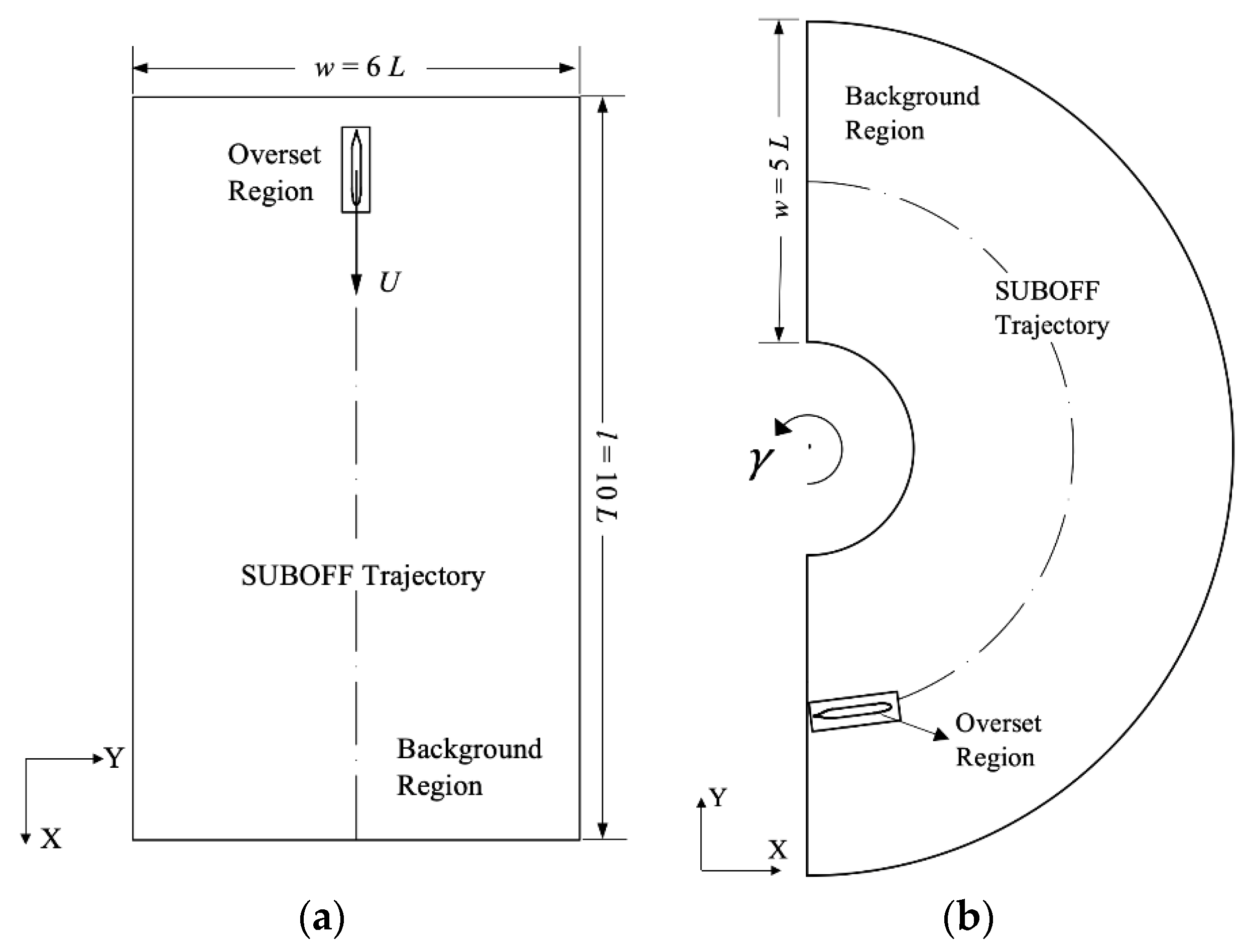
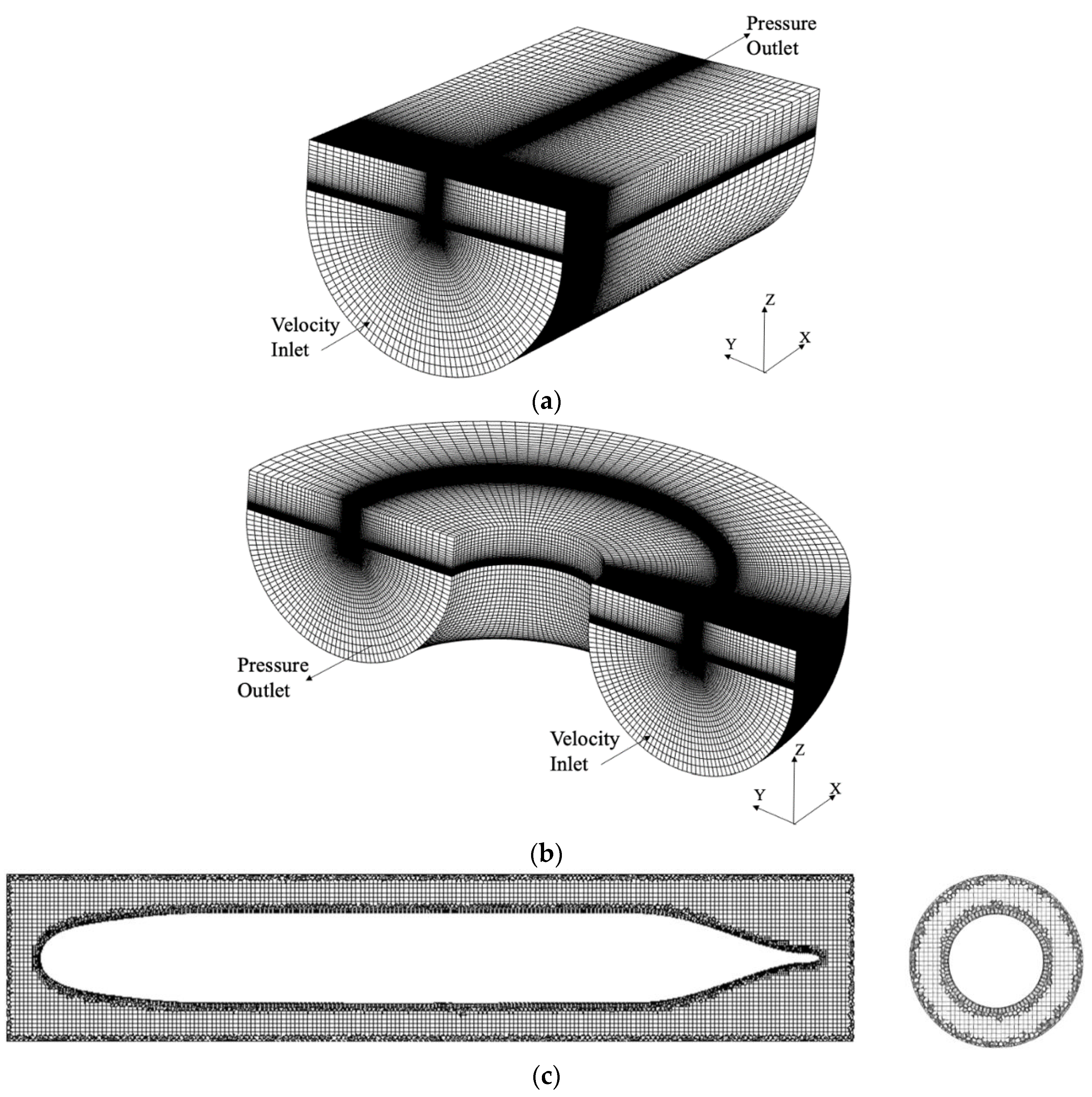



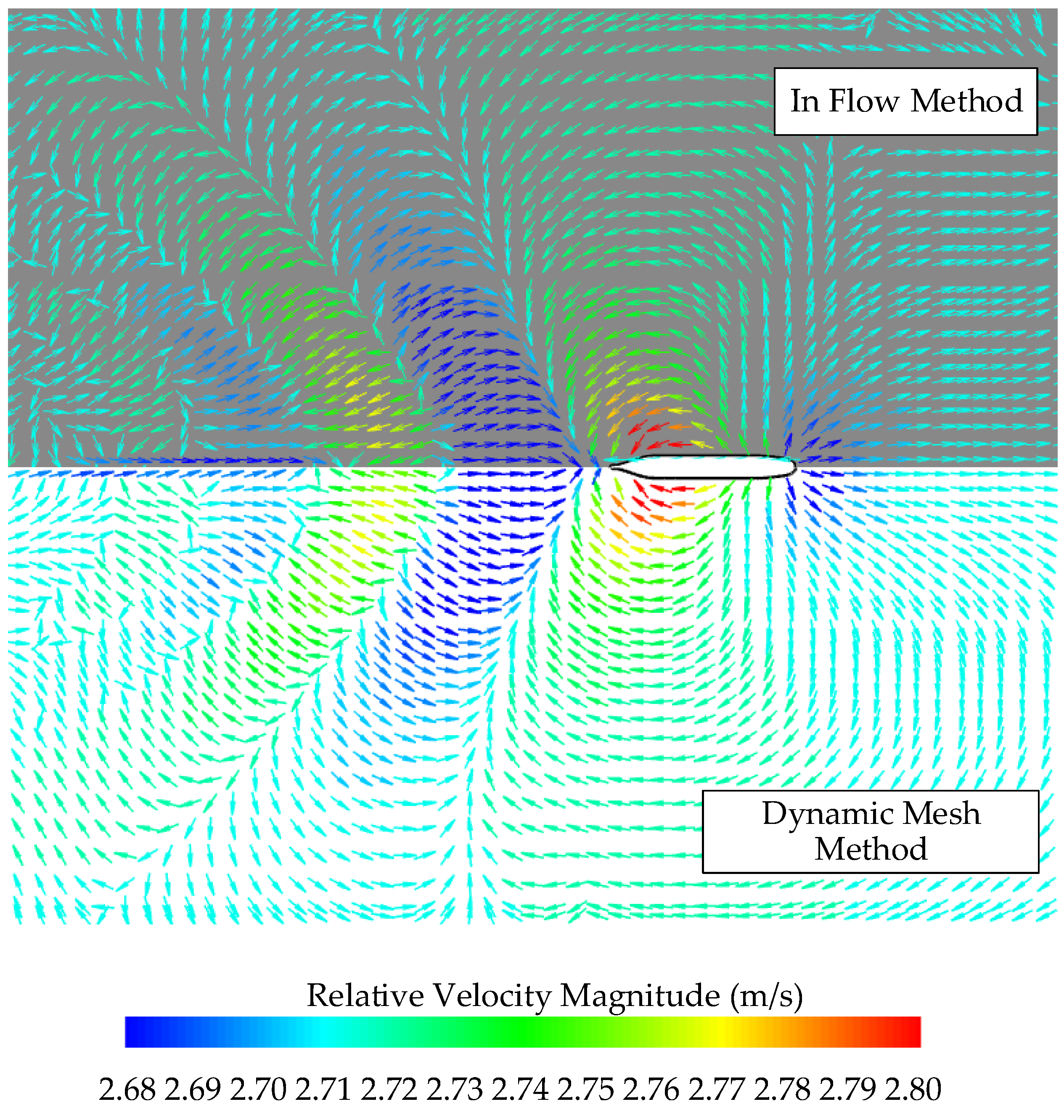
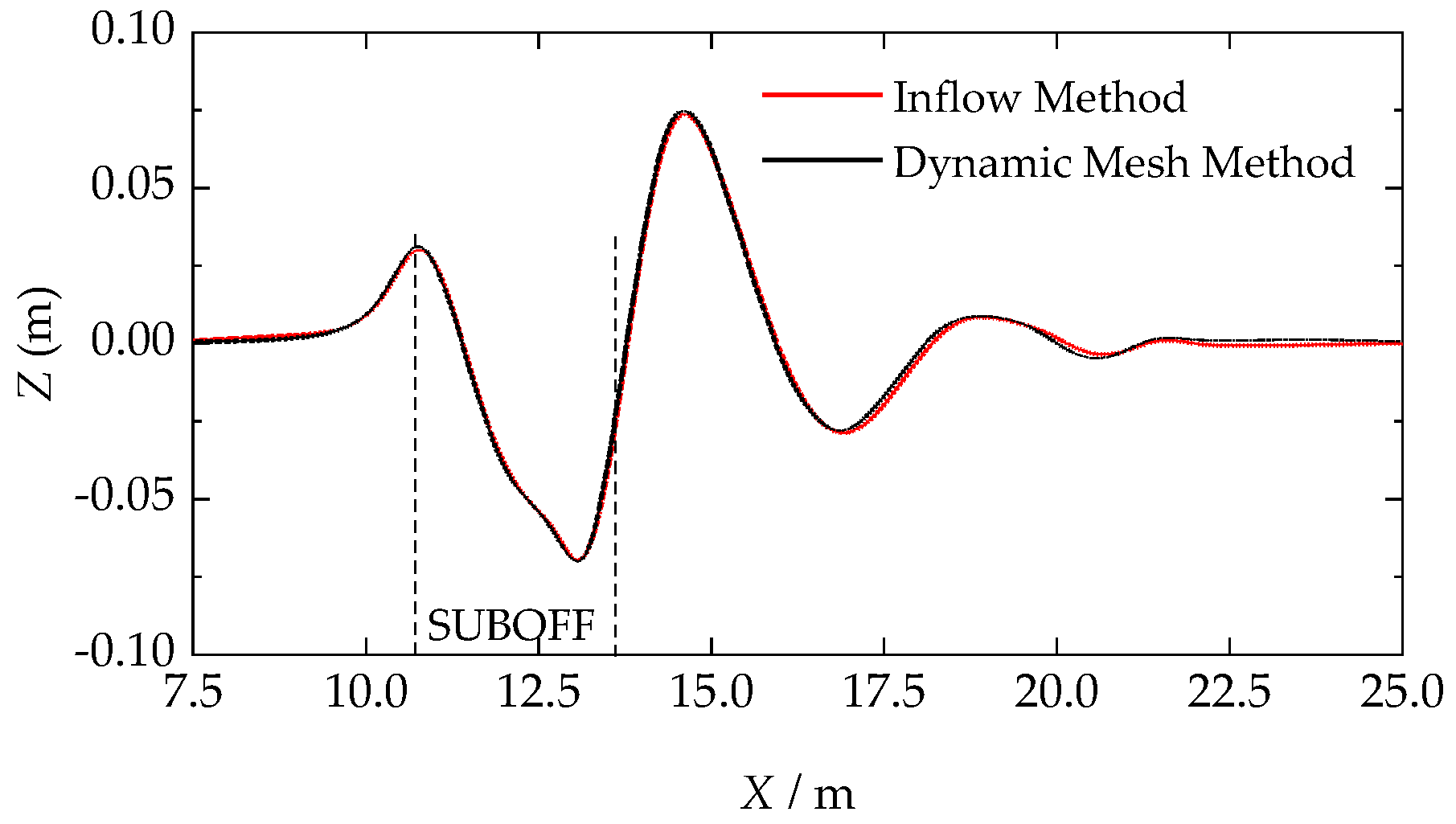
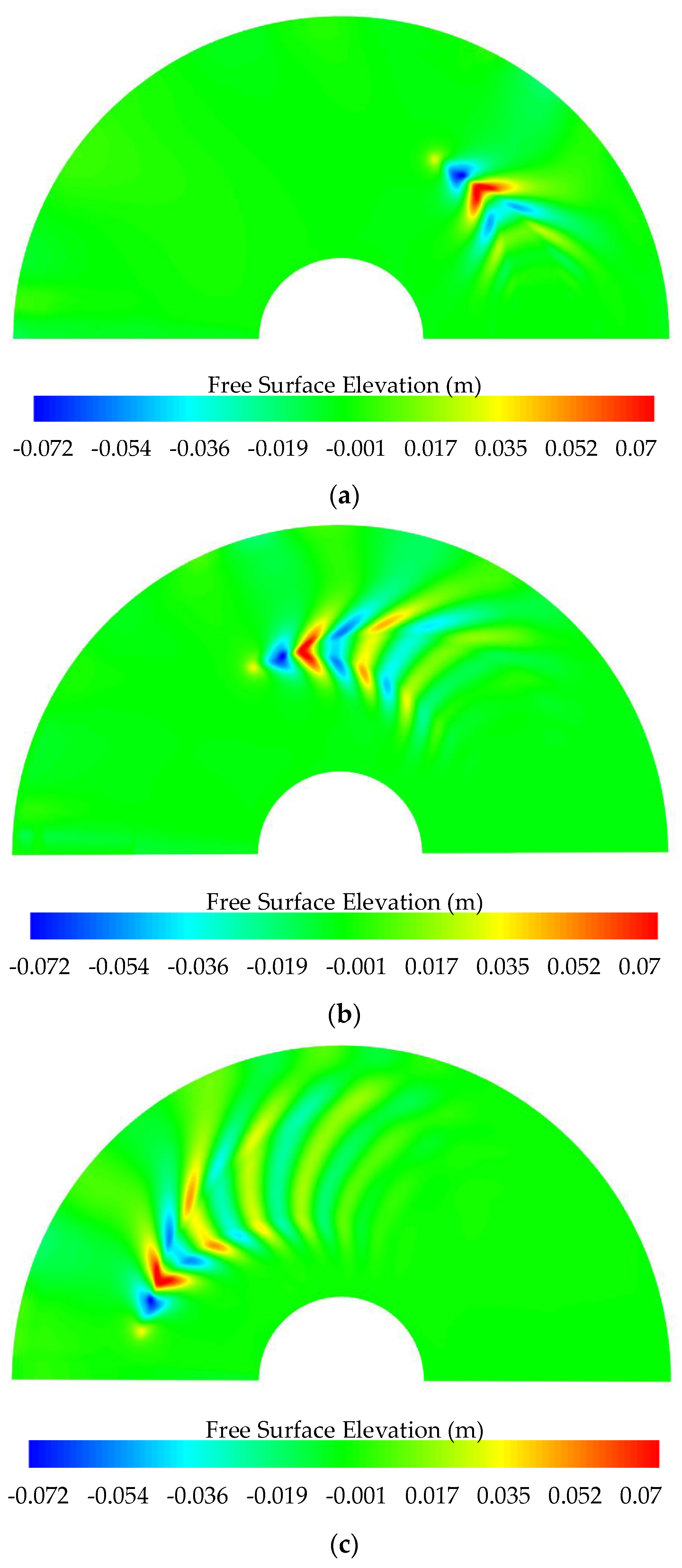

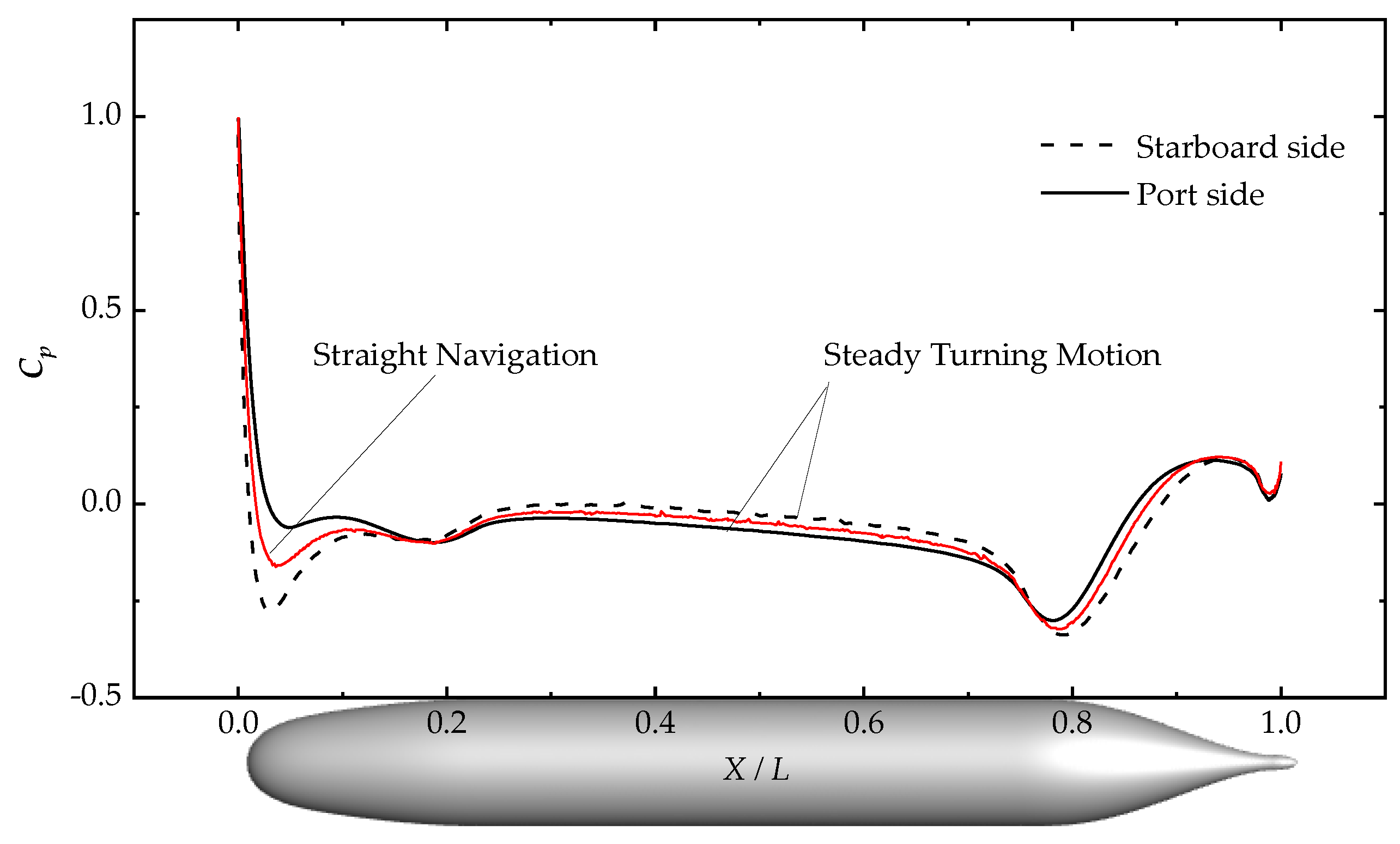
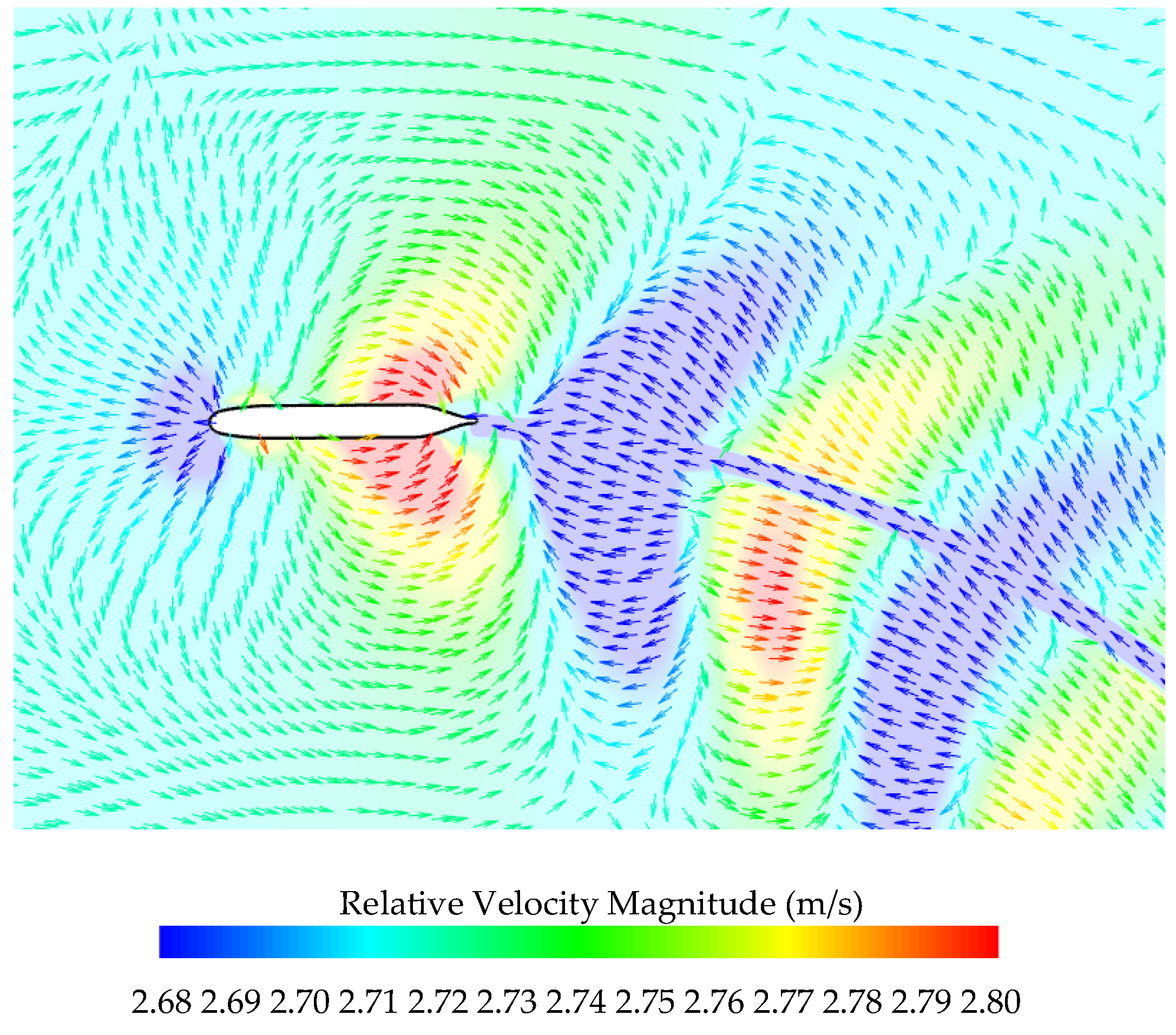

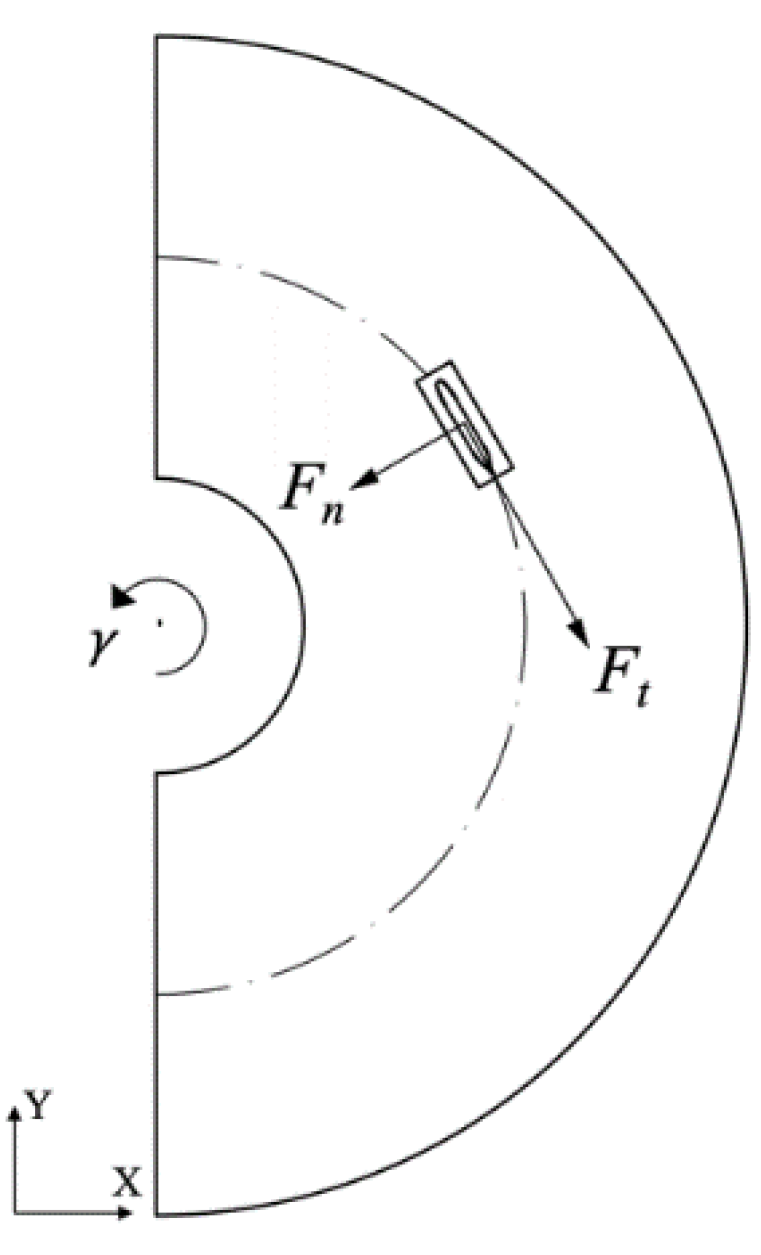

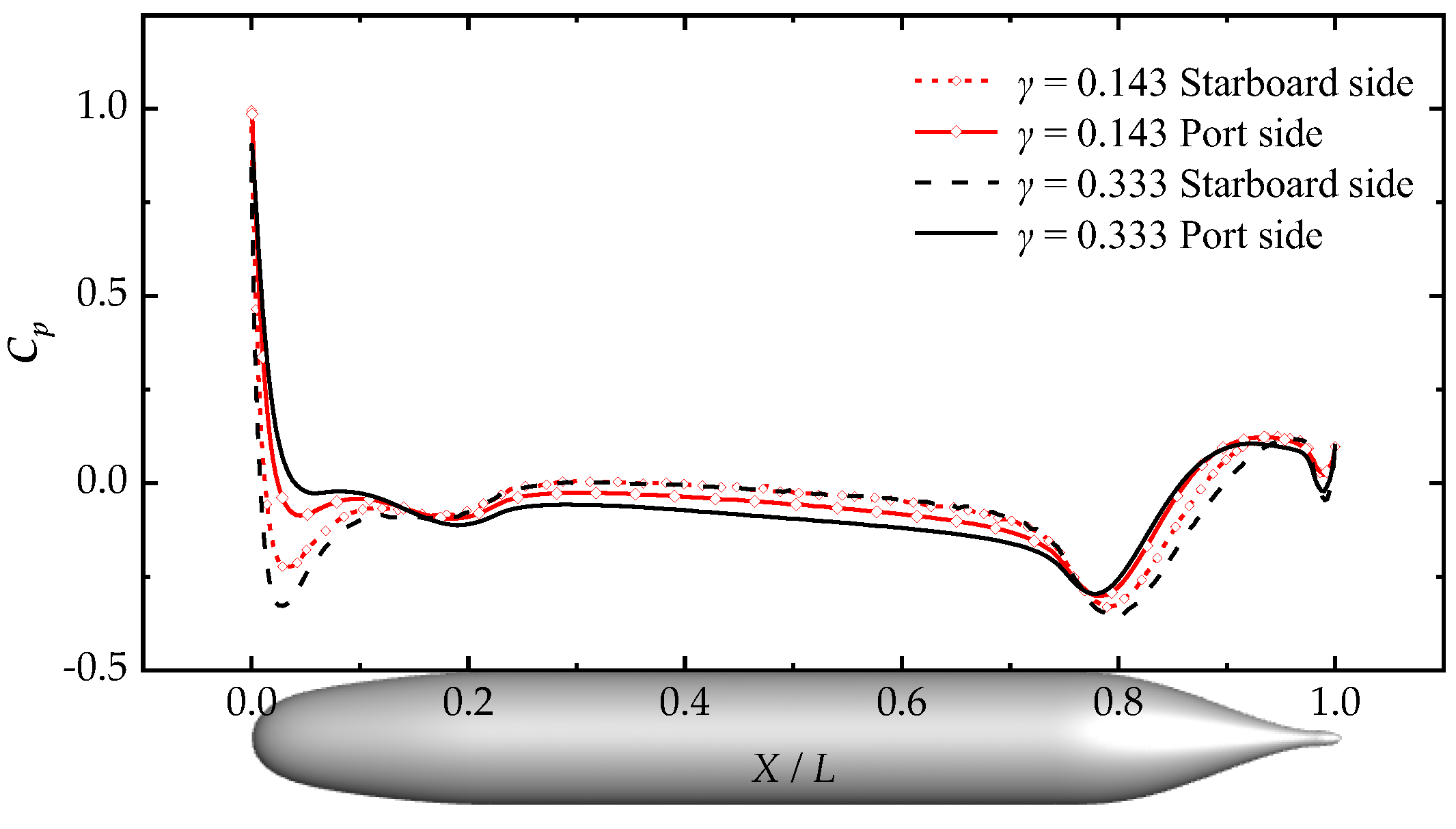
| Basic Size(m) | Net Increase in Cells (Thousand/s) | Total Resistance Rt (N) | Error of Rt (%) |
|---|---|---|---|
| 0.042 | 412.528 | 70.465 | —— |
| 0.063 | 324.429 | 70.461 | 0.006 |
| 0.084 | 206.963 | 69.984 | 0.683 |
| 0.126 | 128.653 | 69.404 | 1.507 |
| Time Step (s) | Number of Steps (Step) | Total Resistance Rt (N) | Error of Rt (%) |
|---|---|---|---|
| 0.005 | 1000 | 70.829 | —— |
| 0.01 | 500 | 70.461 | 0.520 |
| 0.02 | 250 | 69.291 | 2.172 |
| 0.05 | 100 | 68.568 | 3.193 |
| Basic Size(m) | Net Increase in Cells (Thousand/s) | Total Resistance Rt (N) | Error of Rt (%) |
|---|---|---|---|
| 0.0315 | 225.763 | 71.749 | —— |
| 0.042 | 170.822 | 71.342 | 0.568 |
| 0.063 | 115.586 | 70.653 | 1.529 |
| 0.084 | 83.421 | 69.976 | 2.471 |
| Time Step (s) | Number of Steps (Step) | Total Resistance Rt (N) | Error of Rt (%) |
|---|---|---|---|
| 0.005 | 1000 | 71.816 | —— |
| 0.01 | 500 | 71.342 | 0.660 |
| 0.02 | 250 | 70.388 | 1.989 |
| 0.05 | 100 | 69.720 | 2.918 |
| Froude Number Fr (-) | Rotational Radius R (m) | Rotation Rate γ = L/R (-) | Tangential Force Ft (N) | Normal Force Fn (N) | Resultant Force Rt (N) |
|---|---|---|---|---|---|
| 0.5 | 3 L | 0.333 | 69.305 | 19.665 | 72.041 |
| 5 L | 0.200 | 69.938 | 9.575 | 70.590 | |
| 7 L | 0.143 | 69.970 | 3.441 | 70.216 |
Publisher’s Note: MDPI stays neutral with regard to jurisdictional claims in published maps and institutional affiliations. |
© 2022 by the authors. Licensee MDPI, Basel, Switzerland. This article is an open access article distributed under the terms and conditions of the Creative Commons Attribution (CC BY) license (https://creativecommons.org/licenses/by/4.0/).
Share and Cite
He, G.; Zhang, C.; Xie, H.; Liu, S. The Numerical Simulation of a Submarine Based on a Dynamic Mesh Method. J. Mar. Sci. Eng. 2022, 10, 1417. https://doi.org/10.3390/jmse10101417
He G, Zhang C, Xie H, Liu S. The Numerical Simulation of a Submarine Based on a Dynamic Mesh Method. Journal of Marine Science and Engineering. 2022; 10(10):1417. https://doi.org/10.3390/jmse10101417
Chicago/Turabian StyleHe, Guanghua, Cheng Zhang, Hongfei Xie, and Shuang Liu. 2022. "The Numerical Simulation of a Submarine Based on a Dynamic Mesh Method" Journal of Marine Science and Engineering 10, no. 10: 1417. https://doi.org/10.3390/jmse10101417





